Steven Volk, Director, Center for Teaching Innovation and Excellence (Oberlin College), Co-Director GLCA Consortium for Teaching and Learning
December 12, 2016
Where to begin?
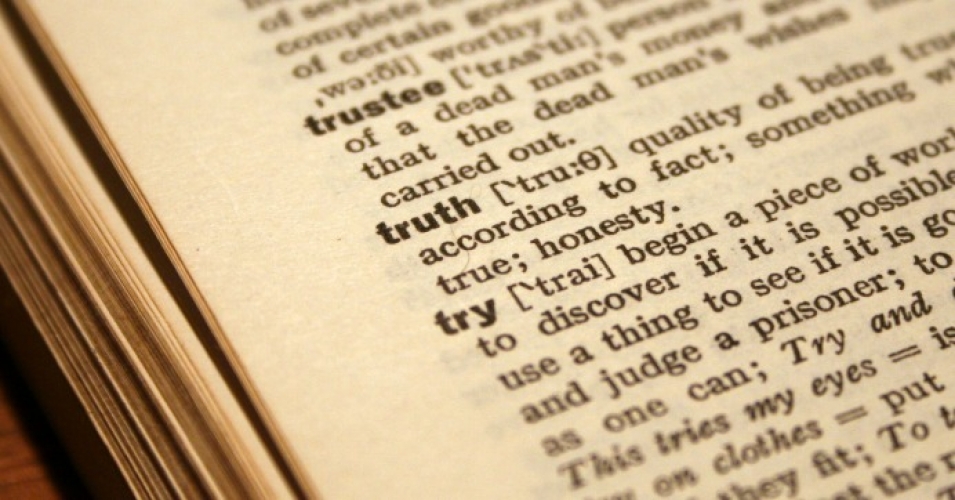
(Photo: Judy van der Velden/flickr/cc)
Why not with a definition of “post-truth” from the Oxford dictionary: “Relating to or denoting circumstances in which objective facts are less influential in shaping public opinion than appeals to emotion and personal belief.” Oxford has selected “post-truth” as its “word of the year,” narrowly besting “bigly.” (OK, that last part was my own rocket into the post-truthian universe.)
Or perhaps we should start with a New York Times headline from the December 7 edition:

From there, it’s but a quick hop to this clip from a CNN interview with a small group of Trump supporters on December 1. You’ve probably seen it, the one where Paula Johnson, a Trump enthusiast from New Hampshire, informed CNN’s Alisyn Camerota that at her (Johnson’s) polling station in Nashua, she caught people voting illegally who told her: “The president said I could vote, I’m here illegally.”
Taken from the perspective of what we naively referred to as “reality,” you’ve got to admit that Johnson’s statement is, well, nuts. I mean, why would someone expose her illegal activity to a total stranger? But let’s leave that aside and go on because the entire panel of Trump backers agreed that President Obama told undocumented people (“illegals” as they prefer to call them) that they could vote. Camerota asked Johnson where she heard that President Obama said the undocumented could vote. “Google it,” Susan DeLemus said. “You can find it on Facebook.” After “Googling it” on her phone and finding a video that had been falsely edited, the CNN reporter observed that Obama “had said nothing of the sort.” This was not a problem for Johnson who, with the endorsement of the other Trump supporters, clung to the belief – now known as “fact” – that “there is voter fraud in this country.”
“There’s no such thing…[as] facts”
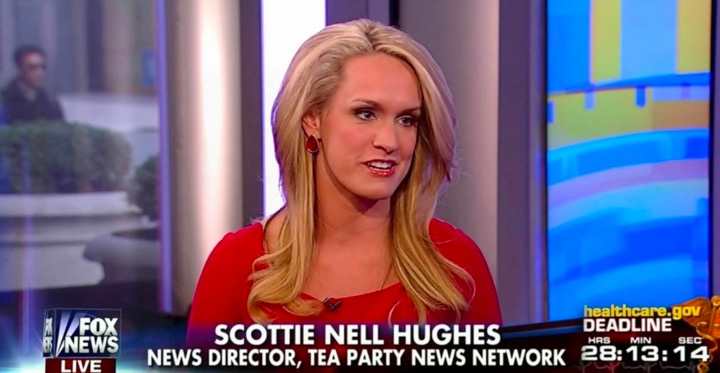 Come along next to the Diane Rehm show from November 30, 2016. Among other guests including James Fallows of The Atlantic and Margaret Sullivan of The Washington Post, Ms. Rehm spoke with Scottie Nell Hughes, described as a “former Donald Trump surrogate” who is a political editor of RightAlerts.com and a contributor to the aforementioned CNN. Hughes joined the program about 20 minutes into the show and was brought into the conversation by Rehm in the following manner:
Come along next to the Diane Rehm show from November 30, 2016. Among other guests including James Fallows of The Atlantic and Margaret Sullivan of The Washington Post, Ms. Rehm spoke with Scottie Nell Hughes, described as a “former Donald Trump surrogate” who is a political editor of RightAlerts.com and a contributor to the aforementioned CNN. Hughes joined the program about 20 minutes into the show and was brought into the conversation by Rehm in the following manner:
Rehm: Now I know you’ve been listening since the top of the program, and I’m sure you’ve heard James Fallows talk about lies that Donald Trump has put out there in tweets, in things he’s said. What do you make of that?
Hughes: Well, I think it’s also an idea of an opinion. And that’s — on one hand I hear half the media saying that these are lies, but on the other half there are many people that go, no, it’s true. And so one thing that has been interesting this entire campaign season to watch is that people that say facts are facts, they’re not really facts. Everybody has a way, it’s kind of like looking at ratings or looking at a glass of half-full water. Everybody has a way of interpreting them to be the truth or not true.
There’s no such thing, unfortunately, anymore of facts. And so Mr. Trump’s tweet amongst a certain crowd, a large — a large part of the population, are truth. When he says that millions of people illegally voted, he has some — in his — amongst him and his supporters, and people believe they have facts to back that up. Those that do not like Mr. Trump, they say that those are lies, and there’s no facts to back it up. So…
When the other journalists gathered their “jaws up from the floor” — and one could fairly ask why Ms. Hughes was given space at a table of journalists — James Fallows, concluded: “I think it actually is an intended result of this campaign and administration to think, well, really there aren’t any facts, it’s all opinion, so we’re going to sort of manipulate the things that we care about.”
The Past of Post-Truth

Is post-truthism a peculiar and ugly side effect of the 2016 presidential campaign? Yes and no. Certainly, anti-intellectualism has long been an observable part of U.S. history: the road from the Know Nothing Party to McCarthyism has been well traveled. Nor is the rejection of observable facts (only) a contemporary malady. As educators trained to pay attention to historical realities and to raise critical questions about them, we should keep in mind that for many members of the U.S. community, the willful and persistent denial of facts all too familiar.
To cite only two examples: On December 6, 2016, a jury of six white men, five white women, and a one black man was unable to come to a unanimous decision that a police officer unlawfully killed Walter L. Scott, a black man who had been pulled over for a broken taillight. This is the case despite the existence of a video that recorded how Scott, who was running away, was shot in the back some 17 feet from the officer. If this stirred memories of the Rodney King trial, it should have. A video showing Rodney King being unmercifully beaten by the Los Angeles police in 1991 was not accepted as fact in the officers’ trial for assault; all were acquitted. As Jelani Cobb recently observed, “Taken in total, the reluctance of juries to hold police accountable is an inversion of the ‘fake news’ crisis in the Presidential election. There, a gullible public believes outrageous claims that reaffirm its world view. In the criminal-justice system, as black America has long known, an indifferent public sees evidence of outrageous actions but chooses not to believe it in order to preserve its world view. We have moved far beyond facts.” Large parts of white America have never accepted many of the facts that smack black Americans in the face every day.
In a similar vein, Elizabeth Kolbert observed that the current political climate suggests not that “too many people do not seem to care about the truth (though this is certainly a huge problem); it’s that a lot of people—an increasing number of them in high government positions—insist that their ravings are true, and try to act on them. This naturally brings them into conflict with those whose job it is to distinguish fact from fiction; hence the subpoenas and attempts to intimidate [journalists and others seeking the facts].”
Post-Truth and Our Responsibilities as Teachers
If journalists are having a hard time rethinking their role under the coming Trump Presidency, what does the post-truth era that he has ushered in mean for educators, we who are tasked with helping students recognize and appreciate the difference between facts and opinion, between informed and uninformed opinion, and between all of the above and a steaming pile of poop? We chuckled when Stephen Colbert invented the idea of “truthiness,” but have stopped laughing in an environment where facts are scorned “because nobody knows what’s really true anyway.”
Here’s a reality check: We are teaching – or attempting to teach – at a moment when the scientific consensus that climate change is both caused by humans and poses a massive threat to the planet’s future is ridiculed by half the population including the incoming head of the EPA. We labor with our students to insure that they are able to craft evidence-based arguments at a moment when Republican-controlled state legislatures (as well as the incoming Attorney General and the President-elect who appointed him) cite articles which claim that “millions of voter registrations are fraudulent or invalid.” This although evidence points to incident rates of voter fraud as lying somewhere between 0.00004 percent and 0.0009 percent. Why trust social science research when you can reference an article in the Federalist which discloses, “stunningly,” that in Colorado, “a woman named Sara Sosa who died in 2009 cast ballots in 2010, 2011, 2012 and 2013”? (What are the chances of two people named “Sara Sosa” living in Colorado? Just saying…)
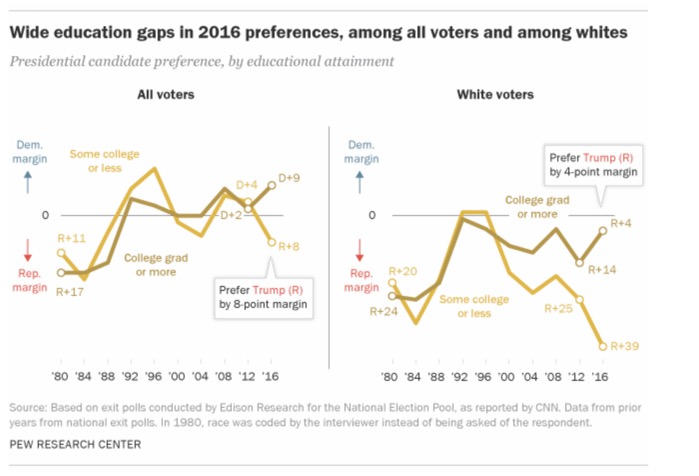 Perhaps we can take a small morsel of consolation from the fact that the truth-crisis that surrounded the election of 2016 can’t be deposited on higher education’s doorstep. After all, Clinton carried college graduates by a 9-point margin. And yet I have felt unnervingly at sea writing this post because my arguments, conscientiously authenticated by links to authoritative sources, would only serve as proof of their irrelevance, if not contemptibility, in the eyes of millions of voters. If Mr. Trump were to tweet that he actually received more votes from the college educated than his opponent, his claim would be accepted as truth by many, if not most, of his supporters.
Perhaps we can take a small morsel of consolation from the fact that the truth-crisis that surrounded the election of 2016 can’t be deposited on higher education’s doorstep. After all, Clinton carried college graduates by a 9-point margin. And yet I have felt unnervingly at sea writing this post because my arguments, conscientiously authenticated by links to authoritative sources, would only serve as proof of their irrelevance, if not contemptibility, in the eyes of millions of voters. If Mr. Trump were to tweet that he actually received more votes from the college educated than his opponent, his claim would be accepted as truth by many, if not most, of his supporters.
What is to be done?
So, what is our role as classroom teachers, members of institutions of higher education, and intellectuals who are also concerned citizens? The past few weeks have produced a profusion of commentary about how those of us in academia should situate ourselves in the post-truth world of President-elect Trump. You can read some general propositions about the stance to take here, here, or here. You can read statements that many college presidents have signed on to. You can investigate the sanctuary campus movement, or take advice as to how we should react to threats to academic and intellectual freedom that can emerge when Trump takes office (and have already emerged in the transition period).
Beyond that, here is my own list of 7 propositions that those of us in higher education can do to challenge the threat of post-truthism in a time of Trump:
(1) Take even more seriously the task of helping students evaluate sources of information. Nicholas Lemann, a professor of journalism and former dean at Columbia, recently made the case for a new kind of core curriculum that includes “information acquisition” as the first item in the list. We can argue about the value of a core curriculum later – an argument I’d relish – but now the focus is not just on our long-standing responsibility to teach “information literacy,” but on the consequences of not taking that responsibility seriously.
For those who seem to think that our students have no trouble identifying credible information sources, think again. Stanford University’s History Education Group recently tested nearly 8,000 students for “civic online reasoning” skills, i.e. the ability to assess the credibility of information served up by smartphones, tablets, and computers. From January 2015 through June 2016 the group collected and studied responses from 7,804 students from 12 states. The schools ranged from “under-resourced” inner-city schools in Los Angeles to “well-resourced” suburban schools in Minneapolis. Testing in colleges ranged from large state universities with near-open enrollment, to Stanford University. What they found was that more than 80% of the tested students couldn’t tell the difference between real news articles and fake news.
For those of us who teach at selective liberal arts colleges, our concern as educators is not – or not solely – that our students are likely to be sucked into the dark vortex of whole-cloth fabrications whose most recent poster child is the Comet Ping Pong insanity (although the fact that such invented conspiracies are being circulated by an important member of the incoming Trump administration, should lead to much concern).
Most of what our students absorb via social media or other internet sites is usually of a lesser order of preposterousness (one hopes). But to the extent that the flow of pixels is constant and constitutes the largest part of the information ocean in which our students (and we) swim, we need to pay attention to how they (and we) are navigating these waters. Take the following tweet which was evaluated as a part of the Stanford study:
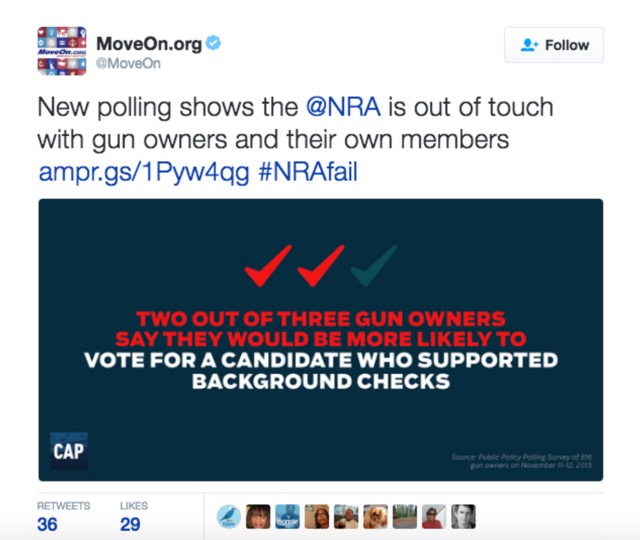
The authors of the study found that:
Only a few students noted that the tweet was based on a poll conducted by a professional polling firm and explained why this would make the tweet a stronger source of information. Similarly, less than a third of students fully explained how the political agendas of MoveOn.org and the Center for American Progress might influence the content of the tweet. Many students made broad statements about the limitations of polling or the dangers of social media content instead of investigating the particulars of the organizations involved in this tweet.
Faculty have work to do, in close partnership with our libraries, about basic online information literacy and cannot assume that our students have a sophisticated understanding of how information is generated in a content zone that has developed outside academic or journalistic oversight, as limited as that might be. Nor is the problem lessened because our students aren’t likely to submit as evidence data that originate on white nationalist sites. We need to ask whether we are we equipping students to bring the same critical eye to more liberal media sources. Do they know what questions to ask about information sources and how to answer them? We need to develop new and sustained ways to help students navigate this information world. We need new courses in information literacy and the funded development of media literacy segments for on-going courses in the regular curriculum.
2) Help students understand (and question) the unspoken authority of the text. If we are not to spend the next 40 years wandering around in an epistemological desert, where all utterances are judged to be as valid (truthful, factual) as any other, we need to help our students understand where the authority that underlies knowledge comes from – and that means being able know on what grounds that authority can be sustained or challenged. And we need to empower students to question authority when necessary.
Especially as liberal arts institutions, we need to build into our courses not only a greater ability to assess information, but a deeper understanding of the ways in which knowledge is generated and the legitimate grounds on which it can be challenged. Acknowledging that Einstein’s General Theory of Relativity reworked Newtonian physics does not prove the scientific method of knowledge-generation to be untrustworthy and that, in consequence, anything that Rush Limbaugh has to say about climate change is as valid as the findings of the Intergovernmental Panel on Climate Change.
The above may be a handy exaggeration, but I would argue that we often fall short on one of the central tasks of liberal arts colleges: engaging students in the central (and different) ways our disciplines produce and authorize knowledge, and that a critical and historical approach towards knowledge-generation is a fundamental part of the on-going work of disciplines. For those who maintain that critical views towards “established” knowledge areas only enhances the arguments of “post-facters,” I would counter that not to question where and how knowledge is generated and established not only leaves the door open to those who would freely invent realities to further their interests, but leaves us poorly positioned to defend the work that we do in colleges and universities. At the end of the day, the best way we can enhance our students’ understanding of the difference between fact and crap is to make them aware of how knowledge is generated, and the ways it can be legitimately challenged.
(3) Be the critics that we are trained to be. Emphasize, at every turn, evidence-based reasoning and the importance of transparency regarding sources and information. Help our students (and our colleagues) question not just the assumptions of others, but their/our own assumptions as well. As Cornel West observed, “It’s not a matter just of having the courage of our convictions, but the courage to attack our convictions.” We need to challenge arguments based on blind appeals to authority. We need to do this not just in our classes but in the broader decisions we make as an educational institution; not just in our institutions, but, as a national community of educators, from early childhood to higher education. And, as a community of educators we need to demand that local, state, and national governments make evidence-based decisions, are transparent about the evidence they bring to decisions making, and are open to discussion, information, and challenge.
(4) Fight ideological and political blacklisting. A variety of news sources have reported that the Trump transition team “wants to know who at the Department of Energy attended domestic and international climate talks. It wants emails about those conferences. It also asks about money spent on loan-guarantee programs for renewable energy. … The Trump team questionnaire also asks… for the 20 highest paid employees at the department’s national laboratories.” The educational community is painfully familiar with ideologically inspired firings and the blacklist, and even the hint of retaliation against those who come to fact-based but inconvenient conclusions cannot be allowed to be normalized. It’s not enough to challenge false news in a “post-truth” environment, we must strongly defend truth and evidence, and those in the academy and outside who produce them.
 (5) Understand why many are pissed off at higher education – and do the work to show what is generating the most serious problems in higher education. Higher education leaders and the faculty in particular have not been forceful defenders of the transformative purpose of higher education, allowing the image to coalesce of college as a snobbish club where it costs a lot to get in, students spend all their time talking nonsense and hiding from ideas they don’t like, and, when finished, move back to their parents’ basement without a job or any “real” skills. We shouldn’t be surprised by the growing anger directed at the higher education sector. Like a carrot dangled in front of a donkey but always out of reach, a college degree is both a necessary means to a more secure future, and increasingly out of reach for a growing percentage of the population. One consequence is that the total outstanding student loan debt in the U.S. is $1.2 trillion, the second-highest level of consumer debt behind only mortgages.
(5) Understand why many are pissed off at higher education – and do the work to show what is generating the most serious problems in higher education. Higher education leaders and the faculty in particular have not been forceful defenders of the transformative purpose of higher education, allowing the image to coalesce of college as a snobbish club where it costs a lot to get in, students spend all their time talking nonsense and hiding from ideas they don’t like, and, when finished, move back to their parents’ basement without a job or any “real” skills. We shouldn’t be surprised by the growing anger directed at the higher education sector. Like a carrot dangled in front of a donkey but always out of reach, a college degree is both a necessary means to a more secure future, and increasingly out of reach for a growing percentage of the population. One consequence is that the total outstanding student loan debt in the U.S. is $1.2 trillion, the second-highest level of consumer debt behind only mortgages.
The problems of the the public higher education sector (representing over 76% of all students), we should be very clear, are rooted in many factors including the growing income inequality produced by stagnating wages, the decline of unions, the growth of an insatiable gazillionaire class, and the increasing unwillingness of state legislatures (i.e., “the public”) to fund post-secondary education. State funding of higher education is down by almost 50% from 1975 to 2011. There are many ideological reasons for a retreat from the very notion of education as a public good, but new research suggests that, “As the population has grown more diverse, support for grand efforts like the GI Bill to open doors to higher education has dwindled. Coincidence?” Anthony Carnevale, a well-regarded educational researcher at Georgetown, found that,
Since the 1990s, the number of black and Latino high school graduates who enroll in college has more than doubled. But three-quarters of that increase has been at open-access colleges. Meanwhile, white college enrollment has increased only at the nation’s top 500 universities. [There are about 4,600 institutions of higher education.] Thus, American higher education has evolved into a two-tiered separate and unequal system that fuels the intergenerational reproduction of white racial privilege.
Put simply, as both the public K-12 system and the public higher education system become progressively non-white, they are increasingly starved of funding. If we support diversity in higher education, as we must, we also are called upon to support funding for that diversity, whether in state funding of higher education or federal funding of Pell and other grants. Whether at public or private institutions, we must fight for the right for higher education for all; fight to sustain the understanding that education is more than skills; fight to make K-12 and higher education a public good; fight to make higher education something that lessens, not increased, inequality in this society.
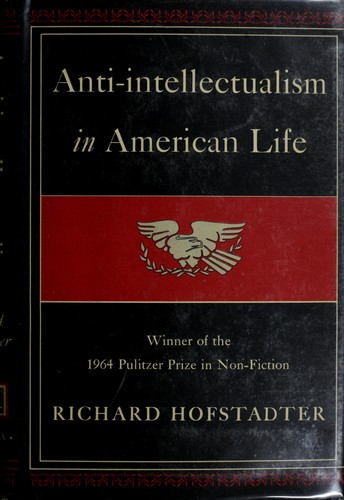 (6) Be humble. With the rise of the Tea Party and the advent of the Trump campaign and his victory, many commentators have returned to Richard Hofstadter’s classic 1963 study, Anti-Intellectualism in American Life. One of the more insightful recent reviews was written by the previously cited Nicholas Lemann in the Columbia Journalism Review. Lemann highlights two quotes from Hofstadter we should consider.
(6) Be humble. With the rise of the Tea Party and the advent of the Trump campaign and his victory, many commentators have returned to Richard Hofstadter’s classic 1963 study, Anti-Intellectualism in American Life. One of the more insightful recent reviews was written by the previously cited Nicholas Lemann in the Columbia Journalism Review. Lemann highlights two quotes from Hofstadter we should consider.
Anti-intellectualism — Hofstadter wrote — is founded in the democratic institutions and the egalitarian sentiments of this country. The intellectual class, whether or not it enjoys many of the privileges of an elite, is of necessity an elite in its manner of thinking and functioning . . . . Intellectuals in the twentieth century have thus found themselves engaged in incompatible efforts: They have tried to be good and believing citizens of a democratic society and at the same time to resist the vulgarization of culture which that society constantly produces. It is rare for an American intellectual to confront candidly the unresolvable conflict between the elite character of his own class and his democratic aspirations.
At a moment when the in-coming President staffs his cabinet with the very same billionaires and Goldman-Sachians he savaged during the campaign, we should not be surprised (as my wife continues to remind me!) that his supporters don’t (yet) see them as the “elites” against which they turn their anger. That anger is still directed at us, the pointy-headed intellectuals. Never mind that power doesn’t reside in Oberlin, Berkeley, or Cambridge. We can tear out our hair over the ludicrousness of this… or we can take to heart another Hofstadter quote:
Intellectuals dwell in the realm of ideas and values, where almost nothing is ever right without qualification. So if anti-intellectualism is a natural aspect of a democratic society, humility ought to be a natural aspect of intellectual life.
Our task is not to make ourselves likable to those who have turned their anger against us. Our task, as critics, is to lay bare the reality of what is happening and at the same time make what we do as educators both relevant and accessible, financially and intellectually, and doing it with humility and a sense of our own limitations.
(7) Insure that our campuses are welcoming, diverse, and supportive. The post-truth environment poses many problems for all of us, but it presents particular threats for the most vulnerable among us, those, as Parker Palmer recently put it, who are at “risk of being bullied, harassed, publicly maligned, physically threatened, denied opportunity, or deported.”
Our campuses must remain not just welcoming for, but fundamentally protective of, these communities. Whether becoming sanctuary campuses or underlining our opposition to racial or religious bigotry, particularly if such attitudes receive a covert or overt support from the highest offices in the land, our job as educators is to defend the inclusiveness of our project and to call out any attempts to challenge or undercut it.
Conclusion
Courtney E. Martin, a prolific author and recipient of the Elie Wiesel Prize in Ethics, recently wrote a column titled “Where I’m Turning to Be Comforted and Challenged.” It’s a stunning piece of writing in which she concludes that she needs art to “cut through the noise” to be the “fact-check from hell.”
I need it — she continues — to disrobe the emperor in a way that all the pundits in the universe cannot. I need it to knee me in the back. I need it to humble and embolden me simultaneously. I need it to paint new worlds that help me understand this one. I need it to yank me out of the haze of the Internet and plop me smack dab in front of another human being staring into my eyes and making me uncomfortable. I need it to reacquaint me with truth. I need it to put marrow back in my bones. I need it to be fearless and maybe even earnest and I need it to come from…a place beyond strategy and semantics, a place of calm indignation, a place of spiritual redemption. I need art to remind me of the immediate danger and convince me of the safety available in collective rebellion.
While it is art that Martin looks toward to find her voice and her community, it is to the liberal arts and to teaching that I look to “put the marrow back in my bones.” We don’t need to stop what we’re doing to confront the challenges of a post-fact world, we need to do what we’re doing better. We need to defend the task of liberal education as a means of creating an “intellectual engagement that fulfills our nature as thinking beings,” as Ramesh Ponnuru recently argued. But we also need to insure that the opportunities to do this are available and accessible to all. At the end of the day, the best way to confront a “post-truth” environment is to continue to do what we do, but to do it better, to do it with humility and conviction, and to do it with the knowledge that failure is unthinkable.

